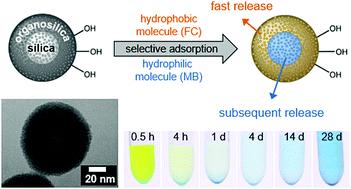当前位置:
X-MOL 学术
›
J. Mater. Chem. B
›
论文详情
Our official English website, www.x-mol.net, welcomes your
feedback! (Note: you will need to create a separate account there.)
Nanoporous hybrid core–shell nanoparticles for sequential release†
Journal of Materials Chemistry B ( IF 6.1 ) Pub Date : 2019-12-09 , DOI: 10.1039/c9tb01846h Mandy Jahns 1, 2, 3, 4, 5 , Dawid Peter Warwas 1, 2, 3, 4 , Marc Robert Krey 1, 2, 3, 4 , Katharina Nolte 1, 2, 3, 4 , Sandra König 4, 6, 7, 8 , Michael Fröba 4, 6, 7, 8 , Peter Behrens 1, 2, 3, 4, 5
Journal of Materials Chemistry B ( IF 6.1 ) Pub Date : 2019-12-09 , DOI: 10.1039/c9tb01846h Mandy Jahns 1, 2, 3, 4, 5 , Dawid Peter Warwas 1, 2, 3, 4 , Marc Robert Krey 1, 2, 3, 4 , Katharina Nolte 1, 2, 3, 4 , Sandra König 4, 6, 7, 8 , Michael Fröba 4, 6, 7, 8 , Peter Behrens 1, 2, 3, 4, 5
Affiliation

|
In this article, a new type of core–shell nanoparticle is introduced. In contrast to most reported core–shell systems, the particles presented here consist of a porous core as well as a porous shell using only non-metal materials. The core–shell nanoparticles were successfully synthesized using nanoporous silica nanoparticles (NPSNPs) as the starting material, which were coated with nanoporous phenylene-bridged organosilica, resulting in a total particle diameter of about 80 nm. The combination of a hydrophilic nanoporous silica core and a more hydrophobic nanoporous organosilica shell provides regions of different chemical character and slightly different pore sizes within one particle. These different properties combined in one particle enable the selective adsorption of guest molecules at different parts of the particle depending on the molecular charge and polarity. On the other hand, the core–shell make-up of the particles provides a sequential release of guest molecules adsorbed at different parts of the nanoparticles. As a proof of concept, loading and release experiments with dyes were performed using non polar fluorescein and polar and charged methylene blue as model guest molecules. Non polar fluorescein is mostly adsorbed on the hydrophobic organosilica shell and therefore quickly released whereas the polar methylene blue, accumulated in the hydrophilic silica core, is only released subsequently. This occurs in small doses for an extended time corresponding to a sustained release over at least one year, controlled by the organosilica shell which acts as a diffusion barrier. An initial experiment with two drugs — non polar ibuprofen and polar and charged procaine hydrochloride — has been carried out as well and shows that the core–shell nanoparticles presented here can also be used for the sequential release of more relevant combinations of molecules.
中文翻译:

用于顺序释放的纳米多孔杂化核-壳纳米颗粒†
本文介绍了一种新型的核壳纳米粒子。与大多数已报道的核-壳系统相反,本文介绍的颗粒由多孔核和仅使用非金属材料的多孔壳组成。使用纳米多孔二氧化硅纳米颗粒(NPSNPs)作为起始材料成功地合成了核-壳纳米颗粒,该纳米颗粒被纳米多孔亚苯基桥连的有机硅包覆,其总粒径约为80 nm。亲水性纳米多孔二氧化硅核和疏水性更强的纳米多孔有机硅壳的组合提供了一个颗粒内具有不同化学特性和孔径略有不同的区域。结合在一个颗粒中的这些不同特性可以根据分子的电荷和极性选择性地将客体分子吸附在颗粒的不同部分。另一方面,颗粒的核-壳组成使吸附在纳米颗粒不同部分的客体分子顺序释放。作为概念的证明,使用非极性荧光素和极性带电的亚甲基蓝作为模型客体分子进行了染料的负载和释放实验。非极性荧光素主要吸附在疏水性有机硅壳上,因此迅速释放,而积累在亲水性二氧化硅核中的极性亚甲基蓝则仅随后释放。小剂量服用会延长时间,相当于至少一年的持续释放,由作为扩散阻挡层的有机硅壳控制。两种药物(非极性布洛芬和极性及带电荷的普鲁卡因盐酸盐)的初始实验也已进行,结果表明,此处介绍的核-壳纳米颗粒也可用于顺序释放更多相关的分子组合。
更新日期:2020-01-04
中文翻译:

用于顺序释放的纳米多孔杂化核-壳纳米颗粒†
本文介绍了一种新型的核壳纳米粒子。与大多数已报道的核-壳系统相反,本文介绍的颗粒由多孔核和仅使用非金属材料的多孔壳组成。使用纳米多孔二氧化硅纳米颗粒(NPSNPs)作为起始材料成功地合成了核-壳纳米颗粒,该纳米颗粒被纳米多孔亚苯基桥连的有机硅包覆,其总粒径约为80 nm。亲水性纳米多孔二氧化硅核和疏水性更强的纳米多孔有机硅壳的组合提供了一个颗粒内具有不同化学特性和孔径略有不同的区域。结合在一个颗粒中的这些不同特性可以根据分子的电荷和极性选择性地将客体分子吸附在颗粒的不同部分。另一方面,颗粒的核-壳组成使吸附在纳米颗粒不同部分的客体分子顺序释放。作为概念的证明,使用非极性荧光素和极性带电的亚甲基蓝作为模型客体分子进行了染料的负载和释放实验。非极性荧光素主要吸附在疏水性有机硅壳上,因此迅速释放,而积累在亲水性二氧化硅核中的极性亚甲基蓝则仅随后释放。小剂量服用会延长时间,相当于至少一年的持续释放,由作为扩散阻挡层的有机硅壳控制。两种药物(非极性布洛芬和极性及带电荷的普鲁卡因盐酸盐)的初始实验也已进行,结果表明,此处介绍的核-壳纳米颗粒也可用于顺序释放更多相关的分子组合。











































 京公网安备 11010802027423号
京公网安备 11010802027423号